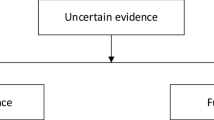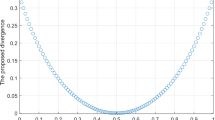Abstract
In the Dempster–Shafer (D–S) evidence theory, how to transform the objective data in reality into the basic probability assignment (BPA) is still an open issue. Based on this problem, a new method of generating BPA based on interval number distance model and reliability is proposed. First, construct the interval number model under each attribute. Second, calculate the interval number distance between the test sample and the interval number model and convert it into the initial basic probability assignment (IBPA). Thirdly, the final BPA is obtained by discounting the IBPA by constructing the comprehensive reliability from the static reliability and dynamic reliability of the interval number model. Finally, the Dempster combination rule is used to fuse the final BPA one by one, and the decision is made according to the fusion result. The ten-fold cross-validation results show that the classification accuracy under the three data sets is higher than other methods, and the classification accuracy of the Iris data set is 0.9733. At the same time, it is verified that the proposed method still has good effectiveness and robustness in the incomplete information environment.










Similar content being viewed by others
Data availability
Enquiries about data availability should be directed to the authors.
References
Dempster AP (1967) Upper and lower probabilities induced by a multivalued mapping. Ann Math Statist 38(2):325–339
Deng X, Liu Q, Deng Y, Mahadevan S (2016) An improved method to construct basic probability assignment based on the confusion matrix for classification problem. Inf Sci 340:250–261
Du Y, Chen Q, Sun Y, Li C (2021) Knowledge structure-based consensus-reaching method for large-scale multiattribute group decision-making. Knowl-Based Syst 219:106885
Dua D, Graff C (2019) UCI machine learning repository [http://archive.ics.uci.edu/ml]. Irvine, CA: University of California, School of Information and Computer Science
Fei L, Xia J, Feng Y, LIu L, (2019) A novel method to determine basic probability assignment in Dempster-Shafer theory and its application in multi-sensor information fusion. Intl J Distrib Sensor Netw 15(7):1550147719865876
Hu Y, Gao J, Hu L, Dong H (2003) A new method of determining the basic belief assignment in DS evidence theory. Proceedings of the 2003 International Conference on Machine Learning and Cybernetics (IEEE Cat. No. 03EX693). IEEE 5: 3208-3211
Jiang W (2018) A correlation coefficient for belief functions. Int J Approx Reason 103:94–106
Jiang W, Wei B, Qin X, Zhan J, Tang Y (2016) Sensor data fusion based on a new conflict measure. Math Probl Eng. https://doi.org/10.1155/2016/5769061
Jiang W, Hu W, Xie C (2017) A new engine fault diagnosis method based on multi-sensor data fusion. Appl Sci 7(3):280
Jiang W, Zhuang M, Xie C (2017) A reliability-based method to sensor data fusion. Sensors 17(7):1575
Kang B, Li Y, Deng Y, Zhang J, Deng X (2012) Determination of basic probability assignment based on interval numbers and its application. Acta Electron Sin 40(6):1092–1096
Khalaj F, Khalaj M (2020) Developed cosine similarity measure on belief function theory: An application in medical diagnosis. Commun Stat Theory Methods. https://doi.org/10.1080/03610926.2020.1782935
Li H, Xiao F (2020) A method for combining conflicting evidences with improved distance function and Tsallis entropy. Int J Intell Syst 35(11):1814–1830
Li J, Xie B, Jin Y, Hu Z, Zhou L (2020) Weighted conflict evidence combination method based on Hellinger distance and the belief entropy. IEEE Access 8:225507–225521
Li R, Chen Z, Li H, Tang Y (2021) A new distance-based total uncertainty measure in Dempster-Shafer evidence theory. Appl Intell. https://doi.org/10.1007/s10489-021-02378-3
Liu Z, Pan Q, Dezert J, Martin A (2017) Combination of classifiers with optimal weight based on evidential reasoning. IEEE Trans Fuzzy Syst 26(3):1217–1230
Liu Y, Pal N, Marathe A, Lin C (2017) Weighted fuzzy Dempster-Shafer framework for multimodal information integration. IEEE Trans Fuzzy Syst 26(1):338–352
Liu Z, Liu Y, Dezert J, Cuzzolin F (2019) Evidence combination based on credal belief redistribution for pattern classification. IEEE Trans Fuzzy Syst 28(4):618–631
Ma W, Liu W, Luo X, McAreavey K, Jiang Y, Ma J (2019) A Dempster-Shafer theory and uninorm-based framework of reasoning and multiattribute decision-making for surveillance system. Int J Intell Syst 34(11):3077–3104
Qiang C, Deng Y (2021) A new correlation coefficient of mass function in evidence theory and its application in fault diagnosis. Appl Intell. https://doi.org/10.1007/s10489-021-02797-2
Qin B, Xiao F (2019) An improved method to determine basic probability assignment with interval number and its application in classification. Int J Distrib Sens Netw 15(1):1550147718820524
Ren Z, Liao H (2021) Combining conflicting evidence by constructing evidence’s angle-distance ordered weighted averaging pairs. Int J Fuzzy Syst 23(2):494–505
Shafer G (1976) A mathematical theory of evidence. Princeton Univ. Press, Princeton, NJ, USA
Si A, Das S, Kar S (2021) Picture fuzzy set-based decision-making approach using Dempster-Shafer theory of evidence and grey relation analysis and its application in COVID-19 medicine selection[J]. Soft Comput. https://doi.org/10.1007/s00500-021-05909-9
Smets P (2005) Decision making in the TBM: the necessity of the pignistic transformation. Int J Approx Reason 38(2):133–147
Song Y, Wang X, Zhu J, Lei L (2018) Sensor dynamic reliability evaluation based on evidence theory and intuitionistic fuzzy sets. Appl Intell 48(11):3950–3962
Tobore I, Kandwal A, Li J, Yan Y, Omisore O, Enitan E, Li S, Liu Y, Wang L, Nie Z (2020) Towards adequate prediction of prediabetes using spatiotemporal ECG and EEG feature analysis and weight-based multi-model approach. Knowl-Based Syst 209:106464
Tu L (2015) Pattern recognition and comprehensive evaluation thodbased on interval numbers. Southwest Jiaotong University, Chengdu
Wang S, Zhao D (2019) A hierarchical power grid fault diagnosis method using multi-source information. IEEE Trans Smart Grid 11(3):2067–2079
Wang S, Jiang F, Zhang B, Ma R, Hao Q (2019) Development of UAV-based target tracking and recognition systems. IEEE Trans Intell Transp Syst 21(8):3409–3422
Wei P, Wang B (2020) Multi-sensor detection and control network technology based on parallel computing model in robot target detection and recognition. Comput Commun 159:215–221
Xiao F (2020) A new divergence measure for belief functions in D-S evidence theory for multisensor data fusion. Inf Sci 514:462–483
Xiao F, Cao Z, Jolfaei A (2020) A novel conflict measurement in decision-making and its application in fault diagnosis. IEEE Trans Fuzzy Syst 29(1):186–197
Xu P, Deng Y, Su X, Mahadevan S (2013) A new method to determine basic probability assignment from training data. Knowl-Based Syst 46(1):69–80
Xu X, Zhang D, Bai Y, Chang L, Li J (2020) Evidence reasoning rule-based classifier with uncertainty quantification. Inf Sci 516:192–204
Zhang J, Deng Y (2017) A method to determine basic probability assignment in the open world and its application in data fusion and classification. Appl Intell 46(4):934–951
Zhang H, Deng Y (2020) Weighted belief function of sensor data fusion in engine fault diagnosis. Soft Comput 24(3):2329–2339
Zhang C, Hu Y, Chan F, Sadiq R, Deng Y (2014) A new method to determine basic probability assignment using core samples. Knowl-Based Syst 69:140–149
Zhang Y, Hu S, Zhou W (2020) Multiple attribute group decision making using J-divergence and evidential reasoning theory under intuitionistic fuzzy environment. Neural Comput Appl 32(10):6311–6326
Zhang R, Xu Z, Gou X (2021) An integrated method for multi-criteria decision-making based on the best-worst method and Dempster-Shafer evidence theory under double hierarchy hesitant fuzzy linguistic environment. Appl Intell 51(2):713–735
Zhang Z, Han D, Dezert J, Yang Y (2017) Determination of basic belief assignment using fuzzy numbers. 2017 20th International Conference on Information Fusion (Fusion) IEEE, PP 1-6
Zhou R, Fang W, Wu J (2020) A risk assessment model of a sewer pipeline in an underground utility tunnel based on a Bayesian network. Tun Undergr Space Technol 103:103473
Acknowledgements
The work is partially supported by the National Natural Science Foundation of China (Grant No. 61771006), Programs for Science and Technology Development in Henan Province of China (Grant Nos. 222102210002, 222102210004) Key Research Projects of University in Henan Province of China (Grant Nos. 20B510001, 21A413002), Innovation and Quality Improvement Program Project for Graduate Education of Henan University (Grant No. SYL20060143).
Funding
The authors have not disclosed any funding.
Author information
Authors and Affiliations
Corresponding author
Ethics declarations
Conflict of interest
The authors declare that they have no conflict of interest.
Ethical approval
This article does not contain any studies with human participants or animals performed by any of the authors.
Additional information
Publisher's Note
Springer Nature remains neutral with regard to jurisdictional claims in published maps and institutional affiliations.
Rights and permissions
Springer Nature or its licensor (e.g. a society or other partner) holds exclusive rights to this article under a publishing agreement with the author(s) or other rightsholder(s); author self-archiving of the accepted manuscript version of this article is solely governed by the terms of such publishing agreement and applicable law.
About this article
Cite this article
Li, J., Xie, B., Jin, Y. et al. Generating method and application of basic probability assignment based on interval number distance and model reliability. Soft Comput 28, 2353–2365 (2024). https://doi.org/10.1007/s00500-023-09325-z
Accepted:
Published:
Issue Date:
DOI: https://doi.org/10.1007/s00500-023-09325-z




